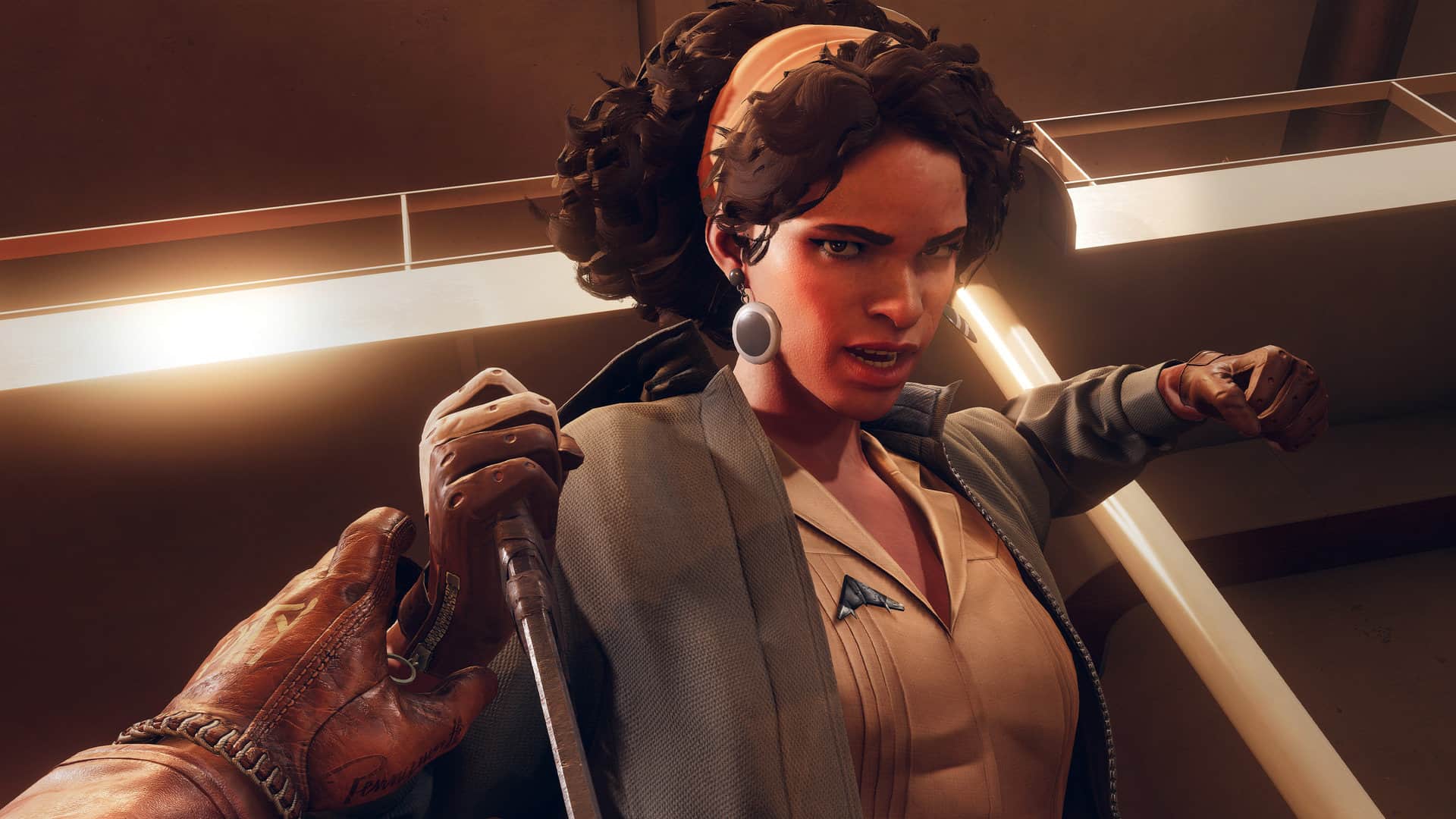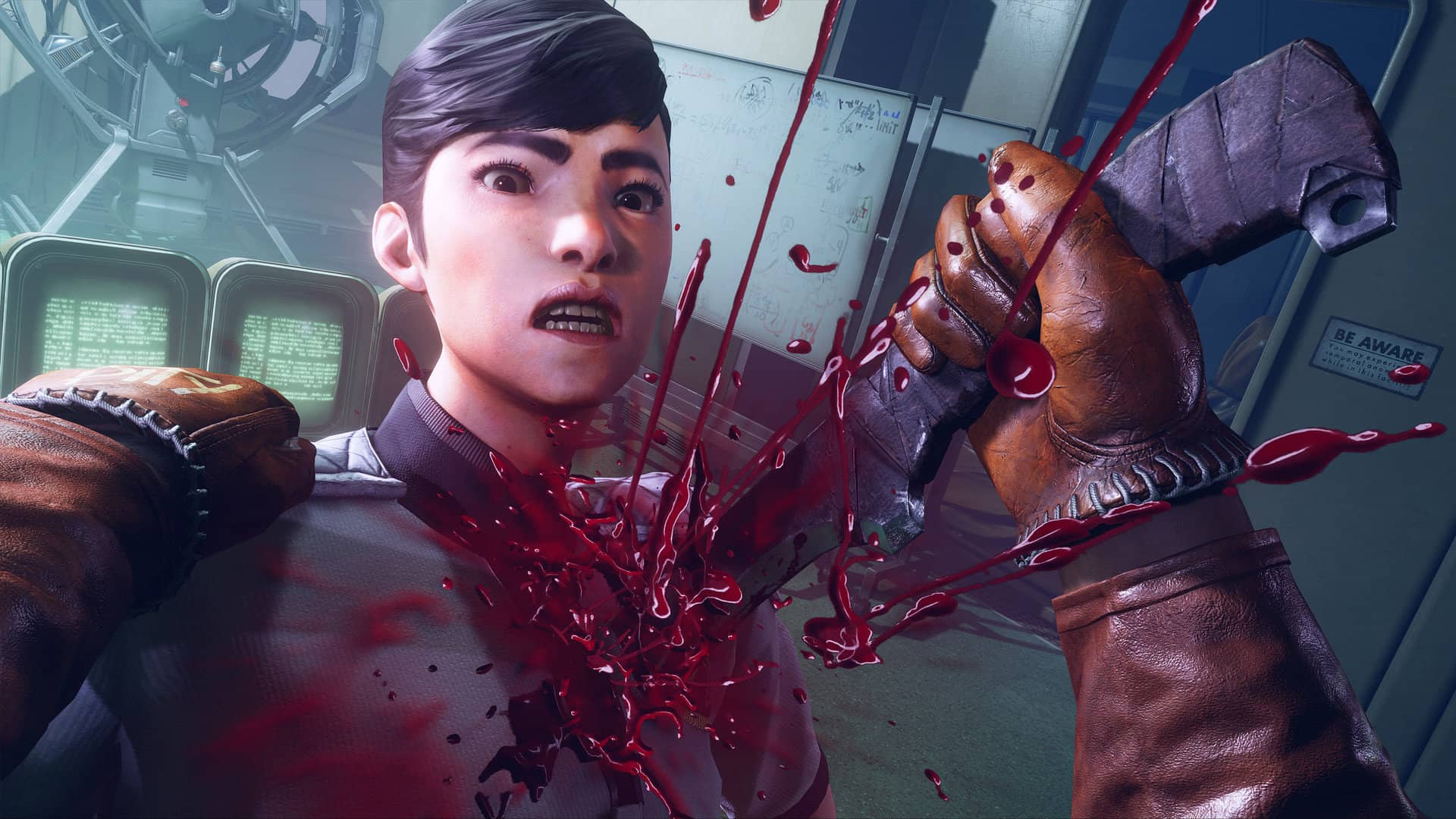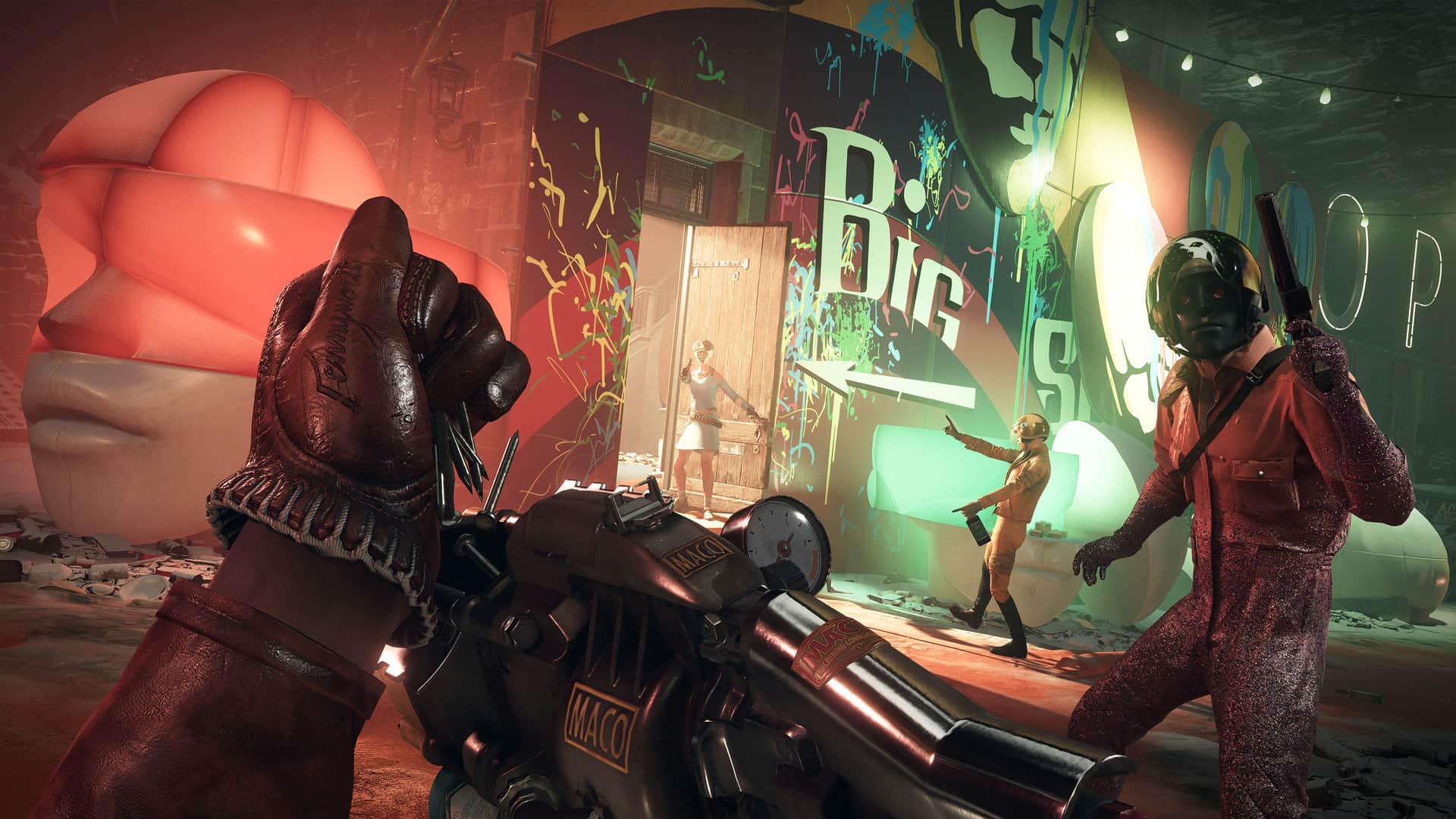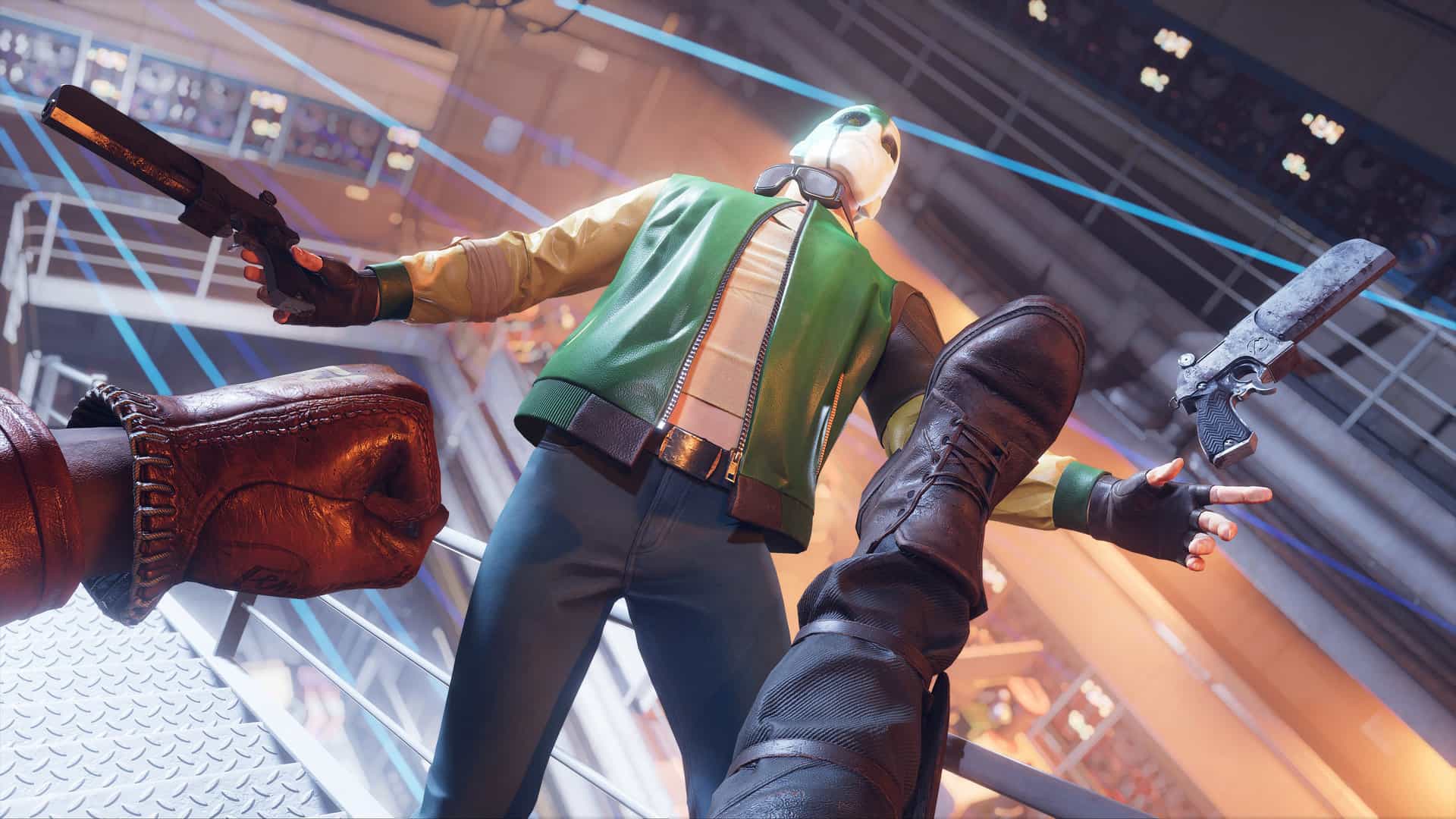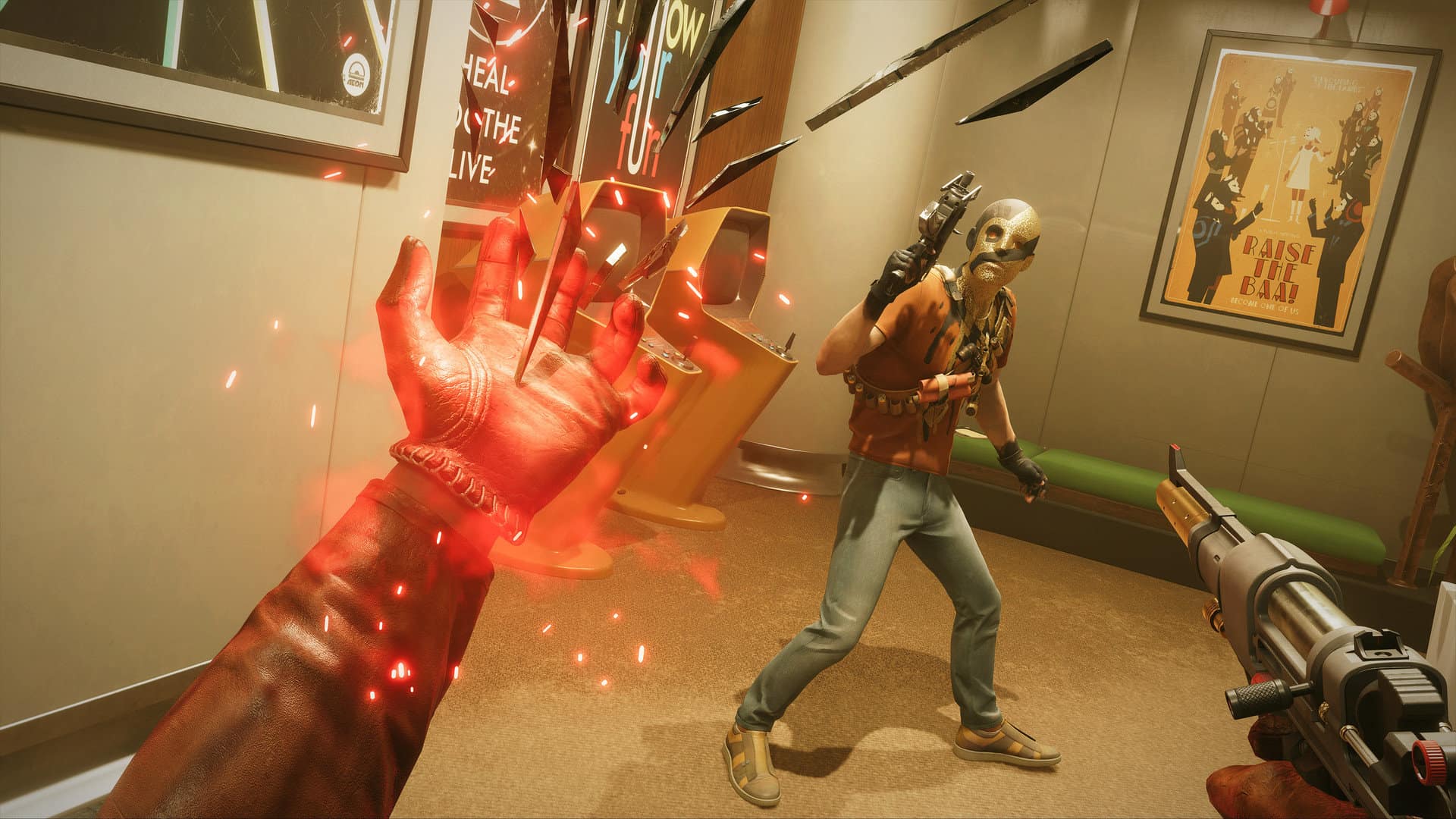Video Gamer is reader-supported. When you buy through links on our site, we may earn an affiliate commission. Prices subject to change. Learn more
EDITOR’S UPDATE (20th September 2022): Deathloop has now launched for the Xbox Series X|S. While it has some new additions in the form of the Goldenloop update, it’s largely the same game.
Therefore, we’re republishing our original review of the game – played on the PlayStation 5 in 2021.
The Isle of Blackreef is hardly holiday-worthy. It is scraped by polar winds, and a miserable sea moans against its coasts. Inland, there is a small town called Updaam, with a few sights worth taking in, but you could do it in a day. Then again, in Blackreef a day is all anyone has. Looming on the horizon is a vast ring of steel, as though one of the Halos from Halo had crash-landed. In its centre is a vibrating metal sphere, and, like a jet engine, it seems to suck in the hours and blast them backwards, to be lived again. For some, this means a frozen paradise—a chance to bask in the heat of a debauched party that will never thaw. For our hero, Colt Vahn, who feels his soul being refrigerated by eternity, it means Hell.
At the outset, Colt wakes on the shore after being impaled on the blade of a woman named Julianna. The two have history, a full day of it, and Julianna recalls everything, whereas Colt is beached in a memoryless fog. She ran him through because he was trying to break the loop. “Why do you even like this place?!” he asks her. “Because it’s amazing!” she says. “It’s the only amazing place in an entire world of s***. You’ll see it, eventually.” This is the crux of Deathloop, from developer Arkane Studios, whose games often centre on amazing places in entire worlds of s***. In Dishonored there was Dunwall, a grey rat-run of disagreeable streets, its furnaces stoked by whale oil. In Prey there was Talos I, a retro space station of brass and glass, like an Art Deco building caught in the lunar pull. Playing those games, as with Deathloop, you sense the ruin of wider worlds eating at the edges like rust.
Arkane’s goal, with these adventures, has been to convert people from Colts into Juliannas: to get them to play a series of enclosed sandboxes over and over, trowelling up the secrets ingrained within, until they grow to love the place. “What’s so amazing about that?” you might ask. To which the Arkane-addicted would reply, “You’ll see it, eventually.” Deathloop, then, is less a departure in its structure than it is the ultimate manifestation of the studio’s time-proof approach. Ironically, it is also, in its embrace of all-out action (your efforts are liberally flowered with the bloom of fireballs), more likely to attract those who would sooner breeze and blast their way through. To gain, as it were, a Colt following.
Not that stealth is off the table. On the contrary, I spent much of the action crouched and sleuthing, aided by a clutch of Slabs—floating doodads that impart supernatural powers. One of these allows Colt to shield his body in a purplish shimmer, rendering himself invisible. Another lets him tether his enemies’ fates together, so that shooting one in the head, for example, will kill several simultaneously. (When they die, your foes ripple away into a rainbow mist and melt on the air; the same thing happened in Control, and the purpose there was as it is here: to remedy your guilt.) There is a nice leaning manoeuvre, where Colt cranes his neck above cover without alerting anyone—useful for hacking turrets and cameras from safety, and turning them against their masters. Only, I wonder if waking up on the sand every morning is doing his back any good, because he would sometimes jerk out of cover mid-peek, as if he had slipped a disc.
Should you opt to treat Deathloop as a straight first-person shooter, you will find it richly rewarding. The game comes to PlayStation 5 and PC, and, if you have the choice, go for the PlayStation version. Arkane has filled the controller with sensations, including, strange to report, nails; note the tinkling as Colt sprinkles a handful of them into the hissing chamber of a nail gun, followed by the gassy pop of the trigger as you fire one at an adversary. Shotguns feel like a deep, lung-clearing cough, hawking up buckshot at anyone in its wide spread. As with Returnal, basic movement is boosted with haptics, so you get a heightened physicality, as each footfall stamps your palms with texture. And Julianna, as she taunts and teases Colt over the radio, crackles through the controller’s speaker.
In a delicious touch, Julianna will appear, often at the most inopportune times, and kill you, as she says, “in increasingly violent ways.” This suggests that she shares at least some DNA with the beast cooked up by Creative Assembly for Alien: Isolation. True, she possesses no writhing tail, and her presence isn’t foretold by trails of drool; nevertheless, she prowls relentlessly after you, and her sarcasm is matched only by her hostility. She is A.I.-driven, but, should you so wish, you can make your single-player game invadable, and your friends can try and stymie your progress, or vice versa. Playing as Julianna is a kick; she can swap guises with N.P.Cs, laying a trap for some poor human-piloted Colt, before closing in for the ambush. There are better miniature stories winding through moments like these than there are in the main narrative.
The plot concerns a group called the Visionaries: eight people, movers and shakers, whose mission is to keep Blackreef from moving at all, even as it shakes the island to its foundations. (Periodically, the enormous hoop lets out a concussive pulse that shudders over the land.) Killing them isn’t too difficult, but the catch is that Colt must dispatch them all in a single day to shatter the loop; thus, his task is one of reconnaissance, of working out, say, that two of his targets like to elope each lunchtime, canoodling right into his crosshairs as a pair. Information is cached within letters and computers, and you follow your leads on a map, which swells like a storm of push-pins and tape. In planning your next move, you can fast forward, and each district changes—crowds thinning, doors unlocking, security defences raising and lowering like the tide.
After each run, you can imbue your weapons and items with Residuum, a substance that carries them through each loop, so that you begin with your chosen gear intact. You also notice the mounting impression, at each sunrise, of a bigger picture falling into place. I was reminded, as the details clicked together, of The Sexy Brutale—a puzzler about a priest lodged in a temporal skip, solving a spree of murders. That game was also locked in a single location—a mansion-bound party, no less—and it fell to you to prevent each death: a wondrous and rare example of the whendunnit. Deathloop, on the other hand, is the reverse; Colt’s operation is low on spiritual virtue and high on brutale.
More than felling each Visionary, however, and piecing together the history of Blackreef, I relished uncovering more about Colt. He is a warm hero, grouchy and gruff, and, though he works out his bearings early on (“I’m a drinker. Occasionally a drunk. Man about island. Everyone knows me. Everyone hates me. Handy with a gun. Quick with a joke”), there remains something elusive about him. “You seem to know what you want without knowing what you want,” one character remarks, and it’s true; Colt is urged on by nothing more than an urge, an inkling that all is not right—that mortal coils are made to be shuffled off. In turn, I was urged on less by a slow-dawning sense that no one lives forever and more by the fond memory of No One Lives Forever, the spy-flavoured sixties shooter, from Monolith Productions, which was as handy with a gun as it was quick with a joke.
The humour in Deathloop is spiked with backchat, rather than all-out spoof, but the aesthetics are similar. I quickly became obsessed with the bulging televisions, encased in bright-coloured plastic, and the rotary dial telephones. One villain’s base would make Frank Lloyd Wright swoon, jutting squarely over a cliff on stark-white pillars. The stylised cutscenes wedged between levels are shaded like Saul Bass title sequences, and the music (by Tom Salta and Ross Tregenza) is tinged with a Bondian twang. I can only guess that Sébastien Mitton, the game’s art director, went about his brief with a desire to conjure a fever of Fleming-style espionage, while grounding it in bleakness and splicing it with sci-fi. The result is a world of swinging thrills that is never far from darkness—where you don’t only live twice, and where tomorrow always dies.
Indeed, there is much of Ken Adam (the production designer behind many of the early Bond movies) here, not just in the elaborate sets—which are happily haunted by his love of rockets, wall-size computers, and modernist interior decor—but in what we might call surface tension: the gap between the quivering cardboard of the design and the weight of real meaning. If there is something lacking in Deathloop, it has to do with emotional staying power. As one egghead, in a scratchy projector film, began to unreel the mythology (“Long ago, the isle of Blackreef experienced a cataclysmic event which tore the fabric of”—and so forth), I realised that I couldn’t care less. Blackreef can go hang. I suspect that the only things that will stick with me—the only things coated with enough Residuum to survive a hard reset—are Colt and Julianna. And maybe that isn’t all bad news. I may replay it at some point, and when I do I’ll be even more like Colt, waking on a beach with the vague prickle of familiarity, and the need to break free.
Developer: Arkane Studios
Publisher: Bethesda Softworks
Available on: PlayStation 5 [reviewed on], Xbox Series X|S, PC
Release Date: September 14, 2021
To check what a review score means from us, click here.


